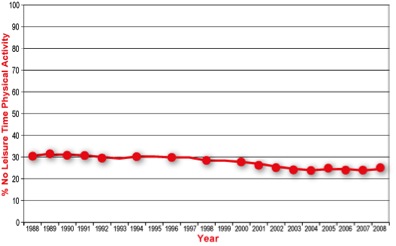Physical Activity: Are We Getting Enough?
A couple of days ago I discussed whether deconditioning should become a distinct medical diagnosis because it is the root cause of so many devastating chronic diseases. In this short post I want to briefly review how much structured exercise or physical activity is enough and whether people are getting enough?
First, let me briefly comment on exercise and physical activity. They are related but not exactly the same thing. Structured exercise includes things like going to the gym, playing in a sports league of some type, or a planned walk or run. In general, anything that is organized and designed as a workout. Physical activity is a broader way to look at things. In addition to formal exercise, it includes things like riding your bike to work, taking the stairs, household chores, unstructured play and other recreational activities.
Second, what are the guidelines? I am attaching a link to the most recent U.S. guidelines for physical activity. They are designed to prevent the development of many of the chronic conditions that result from inactivity. The key numbers are:
“Adults (18-64) should do 2 hours and 30 minutes a week of moderate-intensity, or 1 hour and 15 minutes (75 minutes) a week of vigorous-intensity aerobic physical activity, or an equivalent combination of moderate- and vigorous-intensity aerobic physical activity. Aerobic activity should be performed in episodes of at least 10 minutes, preferably spread throughout the week.”
There are other ideas and numbers out there, but when you look at them in detail most are pretty similar. The guidelines also include specific recommendations for children and older adults along with ideas about strength training.
Third, how is the population doing as a whole in meeting these guidelines? The short answer is terrible. The next link is to a paper that used accelerometers to measure physical activity as part of the NHANES study and the bottom line is that:
“Among adults, adherence to the recommendation to obtain 30 minutes per day of physical activity is less than 5%.”
Fourth, the chart below from the U.S. Centers for Disease Control shows just how many people get no leisure time physical activity at all. Things appear to be getting a bit better over the last 10 years, but 25% of people are completely inactive and as we saw in the chart from a couple days ago, the biggest improvements in health occur when people go from being completely inactive to doing something.
These statistics are a snapshot of just how bad things are. In my next few posts I am going review how much physical activity is “normal” for humans and what can be done about this huge problem. There are many innovative solutions that are working out in the real world, so there is no need to “sit around” and wait for them to happen.
This entry was posted on Friday, August 17th, 2012 at 6:00 am and is filed under Current Events, Physiology, Research and Health. You can follow any responses to this entry through the RSS 2.0 feed. You can leave a response, or trackback from your own site.



September 2nd, 2012 at 9:10 pm
What About Diet? | Human Limits: Michael J. Joyner, M.D. says:[…] calories per day, then we would expect people to gain about 20 lbs (9kg) per year. Also remember from my earlier posts only about 5% of people are meeting the guidelines for physical activity and there has been an […]